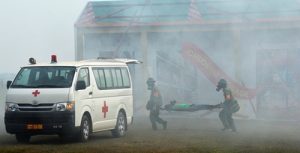Earlier this week, Vietnam and Cambodia held the first iteration of a new search and rescue exercise. The mechanism spotlighted how the two sides are continuing to manage their defense ties amid these wider domestic and foreign policy developments that have tested relations.
Vietnam and Cambodia, two neighboring Southeast Asian states, share a broad defense relationship as part of their wider diplomatic ties. Vietnam provides the Royal Cambodian Armed Forces (RCAF) with military equipment, infrastructure, and training, while both countries have also looked to manage more sensitive areas of the relationship such as outstanding issues over their shared 700-mile long border, illegal fishing, and China’s growing influence in mainland Southeast Asia.
One of the new defense-related interactions that both sides had indicated would take place is a search and rescue exercise. Per details previously released by the Vietnamese military, the exercise, scheduled to take place in Tuasday commune in Chanthrea district in the Cambodian province of Svay Rieng, was expected to see the participation of some 800 people and focus on aspects including the establishment and operation of a joint command post, practicing dealing with chemical incidents and disasters, and post-disaster recovery.
Last week, the exercise kicked off as had been previously indicated by the two sides. Per the official account of the interaction by Vietnam’s defense ministry, the exercise, which began on December 19, was attended by top defense officials on both sides, including Cambodia’s deputy prime minister and Vietnam’s deputy defense minister.
The simulated scenario for the exercise focused on the low-level atmospheric circulation of a tropical cyclone, which had caused chemical spills in several areas of Chanthrea district in the Cambodian province of Svay Rieng and subsequently saw Vietnamese and Cambodian personnel cooperating to establish and operate a joint command post to deal with the incident. In terms of participating personnel, Vietnam sent troops from the Corps, the Military Region 7 Command, and the Long An Provincial Military Command to the exercise, while Cambodia sent troops from the Svay Rieng Military Sub-region, a border guard battalion and the Gendarmerie of Svay Rieng province, and personnel from other relevant units.
The significance of the exercises ought to be understood as part of ongoing efforts to enhance efforts on search and rescue between them, as well as to increase collaboration in the defense side more generally. Ahead of the exercise, the two sides framed the carrying out of this first-of-its-kind drill was framed around operationalizing a previously signed protocol on natural disaster prevention as well as to promote coordination between local personnel across the common border more broadly. And in remarks given at the exercise itself, the defense ministers on both sides highlighted the importance of promoting links between the national defense ministries, local military authorities, and common people, which was further reinforced by other activities carried out alongside the exercise such as the inauguration of a civilian-military friendship infirmary as well as the transfer of medical equipment and gifts to local people.
To be sure, this is just one among several defense-related interactions between the two countries. Furthermore, given that this is a new engagement, a more robust assessment of its significance will be more possible once we see how both sides shape it over time in future iterations. Nonetheless, interactions such as these will be important to continue to monitor over the coming months and years to get a sense of how both sides are tangibly implementing previously identified objectives and operationalizing defense collaboration while managing wider opportunities and challenges in their ties.

































